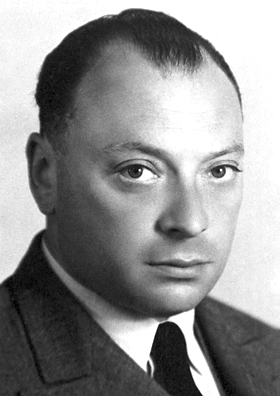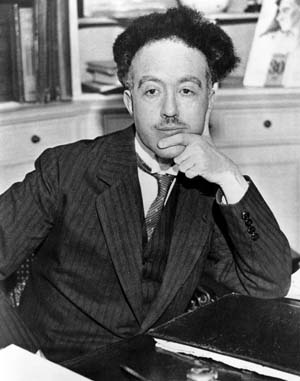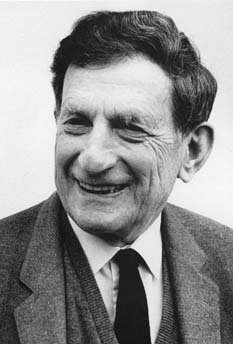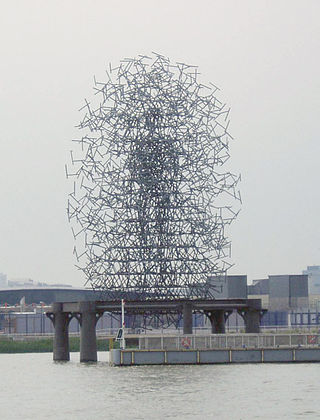Related Research Articles

The Einstein–Podolsky–Rosen (EPR) paradox is a thought experiment proposed by physicists Albert Einstein, Boris Podolsky and Nathan Rosen which argues that the description of physical reality provided by quantum mechanics is incomplete. In a 1935 paper titled "Can Quantum-Mechanical Description of Physical Reality be Considered Complete?", they argued for the existence of "elements of reality" that were not part of quantum theory, and speculated that it should be possible to construct a theory containing these hidden variables. Resolutions of the paradox have important implications for the interpretation of quantum mechanics.

Wolfgang Ernst Pauli was an Austrian theoretical physicist and one of the pioneers of quantum physics. In 1945, after having been nominated by Albert Einstein, Pauli received the Nobel Prize in Physics for his "decisive contribution through his discovery of a new law of Nature, the exclusion principle or Pauli principle". The discovery involved spin theory, which is the basis of a theory of the structure of matter.

Louis Victor Pierre Raymond, 7th Duc de Broglie was a French physicist and aristocrat who made groundbreaking contributions to quantum theory. In his 1924 PhD thesis, he postulated the wave nature of electrons and suggested that all matter has wave properties. This concept is known as the de Broglie hypothesis, an example of wave–particle duality, and forms a central part of the theory of quantum mechanics.

Synchronicity is a concept first introduced by analytical psychologist Carl G. Jung "to describe circumstances that appear meaningfully related yet lack a causal connection." In contemporary research, synchronicity experiences refer to one's subjective experience that coincidences between events in one's mind and the outside world may be causally unrelated to each other yet have some other unknown connection. Jung held that this was a healthy, even necessary, function of the human mind that can become harmful within psychosis.

David Joseph Bohm was an American-Brazilian-British scientist who has been described as one of the most significant theoretical physicists of the 20th century and who contributed unorthodox ideas to quantum theory, neuropsychology and the philosophy of mind. Among his many contributions to physics is his causal and deterministic interpretation of quantum theory, now known as De Broglie–Bohm theory.
Bohm Dialogue is a freely flowing group conversation in which participants attempt to reach a common understanding, experiencing everyone's point of view fully, equally and nonjudgmentally. This can lead to new and deeper understanding. The purpose is to solve the communication crises that face society, and indeed the whole of human nature and consciousness. It utilizes a theoretical understanding of the way thoughts relate to universal reality. It is named after physicist David Bohm who originally proposed this form of dialogue.
In physics, hidden-variable theories are proposals to provide explanations of quantum mechanical phenomena through the introduction of hypothetical entities. The existence of fundamental indeterminacy for some measurements is assumed as part of the mathematical formulation of quantum mechanics; moreover, bounds for indeterminacy can be expressed in a quantitative form by the Heisenberg uncertainty principle. Most hidden-variable theories are attempts to avoid quantum indeterminacy, but possibly at the expense of requiring the existence of nonlocal interactions.
Implicate order and explicate order are ontological concepts for quantum theory coined by theoretical physicist David Bohm during the early 1980s. They are used to describe two different frameworks for understanding the same phenomenon or aspect of reality. In particular, the concepts were developed in order to explain the bizarre behaviors of subatomic particles which quantum physics describes and predicts with elegant precision but struggles to explain.
Holism in science, holistic science, or methodological holism is an approach to research that emphasizes the study of complex systems. Systems are approached as coherent wholes whose component parts are best understood in context and in relation to both each other and to the whole. Holism typically stands in contrast with reductionism, which describes systems by dividing them into smaller components in order to understand them through their elemental properties.
Michael Coleman Talbot was an American author of several books highlighting parallels between ancient mysticism and quantum mechanics, and espousing a theoretical model of reality that suggests the physical universe is akin to a hologram based on the research and conclusions of David Bohm and Karl H. Pribram. According to Talbot ESP, telepathy, and other paranormal phenomena are a product of this holographic model of reality.

The Quantum Cloud is a contemporary sculpture, designed by Antony Gormley, located next to The O2 in London. The sculpture was commissioned for the site and was completed in 1999.
John Briggs is an American author and co-author of general audience nonfiction books in the fields of holistic physics; aesthetics in the arts; creativity, creative process, and consciousness studies. Emeritus Distinguished CSU Professor of Writing and Aesthetics at Western Connecticut State University, Briggs lives in Granville, Massachusetts, where he has served as a Selectman and a police officer.

In the philosophy of mind, double-aspect theory is the view that the mental and the physical are two aspects of, or perspectives on, the same substance. It is also called dual-aspect monism, not to be confused with mind–body dualism. The theory's relationship to neutral monism is ill-defined, but one proffered distinction says that whereas neutral monism allows the context of a given group of neutral elements to determine whether the group is mental, physical, both, or neither, double-aspect theory requires the mental and the physical to be inseparable and mutually irreducible.
The quantum mind or quantum consciousness is a group of hypotheses proposing that classical mechanics alone cannot explain consciousness, positing instead that quantum-mechanical phenomena, such as entanglement and superposition, may play an important part in the brain's function and could explain critical aspects of consciousness. These scientific hypotheses are as yet untested, and can overlap with quantum mysticism.
The quantum potential or quantum potentiality is a central concept of the de Broglie–Bohm formulation of quantum mechanics, introduced by David Bohm in 1952.
The Pari Center for New Learning is a non-profit educational center located in the village of Pari in Civitella Paganico of the Province of Grosseto, Italy. The center was directed by F. David Peat, who co-authored the book Science, Order, and Creativity with theoretical physicist David Bohm. The center has hosted, with the support of its renowned fellows from academia and the arts, the academy Accademia dei Pari. It hosts international conferences on the role of trust and ethics in the world of economics and business, and conferences on the relationship between religion and science.
Basil J. Hiley, is a British quantum physicist and professor emeritus of the University of London.
Paavo Pylkkänen is a Finnish philosopher of mind. He is an Associate Professor of Philosophy at the University of Skövde and a university lecturer in theoretical philosophy at the University of Helsinki. He is known for his work on mind-body studies, building on David Bohm's interpretation of quantum mechanics, in particular Bohm's view of the cosmos as an enfolding and unfolding whole including mind and matter.

Science, Order, and Creativity is a book by theoretical physicist David Bohm and physicist and writer F. David Peat. It was originally published 1987 by Bantam Books, USA, then 1989 in Great Britain by Routledge. The second edition, published in 2000 after Bohm's death, comprises a new foreword by Peat as well as an additional introductory chapter, in which a fictitious dialogue between Bohm and Peat serves to introduce the reader to the context and topics of the book.

Pari is a village in Tuscany, central Italy, administratively a frazione of the comune of Civitella Paganico, province of Grosseto, in the area of the Ombrone Valley. At the time of the 2001 census its population amounted to 204.
References
- ↑ Science, Order, and Creativity, by David Bohm and F. David Peat, 1987, Bantam Books, front matter (British Library Cataloguing in Publication Data)
- ↑ David F. Peat, curriculum vitae, Homepage of F. D. Peat (from the Internet Archive, 6 May 2017).
- ↑ Look for Truth - No Matter Where It Takes You, Interview of F. David Peat by Simeon Alev (from Internet Archive, 18 October 2016). Originally published in: What is Enlightenment? Spring/Summer 1997, Volume 6, Number 1
- ↑ Pari Center for New Learning: Faculty (from the Internet Archive, 9 August 2016).
- ↑ Fetzer Institute: David Peat (from the Internet Archive, 16 June 2010).
- ↑ Maureen Doolan, biography, Pari Center
- ↑ The Center, website of the Pari Center
- ↑ Gentle Action: A Better Way. Building a Basis for Action, by F. David Peat and John Miller (from the Internet Archive, 8 September 2015).
- ↑ Stefanos Michiotis: Public dialogue and strategic planning using methods based on complexity and archetypes, International Journal of Decision Sciences, Risk and Management 2010, vol. 2, no. 1/2, pp. 129–145, doi : 10.1504/IJDSRM.2010.034676, p. 142.